
 |
|
BLESSING OF SEEDS
We fervently entreat thee, O Lord, to bless these seeds, preserve and foster them with gentle breezes, fertilize them with heavenly dew, and deign to bring them to a full harvest for the use of soul and body. Through Christ our Lord. Amen. BLESSING OF BEES
O Lord God Almighty, Maker of heaven and earth! Thou didst create all living things for man's use. Moreover, thou didst order by the ministry of thy holy Church that candles made from the industry of bees shall burn during the Sacred Mystery in which we consecrate and consume the most holy Body and Blood Jesus Christ, thy Son. Send thy holy blessing upon these bees and this beehive to make them numerous and productive, and to preserve them from harm, so that their yield of pollination, wax and honey can be turned to thy honor, and to the honor of they Son and Holy Spirit, and to the veneration of the Blessed Virgin Mary. Through the same Christ our Lord. |

 People often wonder: why do we have land? From its foundation, the Abbey of Regina Laudis has recognized the importance of the land in developing and sustaining a Benedictine way of life and spirituality. In 1947 our foundress Lady Abbess received 50 acres of land on a hill in Bethlehem, Connecticut from Robert Leather, a local industrialist, with the condition that this land would be a place where many people could come to know and to praise God. Lady Abbess’ founding vision brought together the development of this land with the personal growth in call of each person who worked and prayed upon it, a vision which we continue to bring forward as we strive to integrate our work and our prayer through wise stewardship. Since then, the Abbey has grown to comprise approximately 450 acres of cultivated land and wilderness, including a non-commercial working farm, professionally operated by the community. The manual labor required to fulfill this call characterizes our Benedictine life, ...for then are they truly monks when they live by the labour of their hands. (Rule of St. Benedict, Chapter 48) People often wonder: why do we have land? From its foundation, the Abbey of Regina Laudis has recognized the importance of the land in developing and sustaining a Benedictine way of life and spirituality. In 1947 our foundress Lady Abbess received 50 acres of land on a hill in Bethlehem, Connecticut from Robert Leather, a local industrialist, with the condition that this land would be a place where many people could come to know and to praise God. Lady Abbess’ founding vision brought together the development of this land with the personal growth in call of each person who worked and prayed upon it, a vision which we continue to bring forward as we strive to integrate our work and our prayer through wise stewardship. Since then, the Abbey has grown to comprise approximately 450 acres of cultivated land and wilderness, including a non-commercial working farm, professionally operated by the community. The manual labor required to fulfill this call characterizes our Benedictine life, ...for then are they truly monks when they live by the labour of their hands. (Rule of St. Benedict, Chapter 48)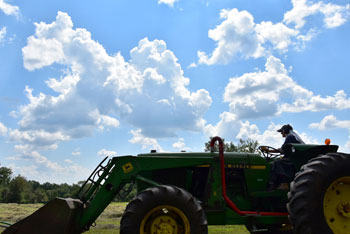 In the process, we often hear that the common stereotype of a nun is broken when our guests see a community member driving a tractor or working with a chainsaw, expanding the notion of what it means to be a contemplative Benedictine nun. Among the varied works undertaken on our land, we manage our hay fields and pastures, typically harvesting 6,000-8,000 hay bales a year, which feed our flocks and herds. We process wood from clearing projects on our land to sell in our woodlot; and we harvest and preserve fruits and vegetables from our gardens and orchards, as well as honey from our own apiary. In the process, we often hear that the common stereotype of a nun is broken when our guests see a community member driving a tractor or working with a chainsaw, expanding the notion of what it means to be a contemplative Benedictine nun. Among the varied works undertaken on our land, we manage our hay fields and pastures, typically harvesting 6,000-8,000 hay bales a year, which feed our flocks and herds. We process wood from clearing projects on our land to sell in our woodlot; and we harvest and preserve fruits and vegetables from our gardens and orchards, as well as honey from our own apiary.ABBEY FIREWOOD FOR SALE—SEASONED MIXED HARDWOODS! $220 per cord; split, aged, mixed dry hardwoods Customer must be able to pick up. 273 Flanders Rd. Bethlehem, CT 06751 203-266-7727 Call for appointment.
Click to enlarge a photo.
HAY HARVESTWatch a video of the mowed hay being lifted and fluffed so hay can be dry for baling.
MOTHER AUGUSTA FEATURED IN ARTICLE: BELTED GALLOWAY CATTLE AT THE ABBEY OF REGINA LAUDIS, 2016 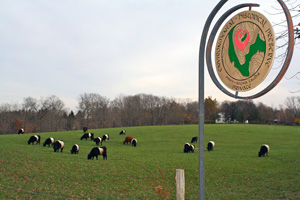 Mother Augusta and the Abbey's beef herd, comprised of the Belted Galloway cattle breed, are featured in the newly-released 3rd edition of The Belted Galloway Journal 2016. In this 4-page article, beautifully written by Kara Keeton, Mother Augusta recounts the history of Regina Laudis and the vision of our Foundress, Lady Abbess Benedict Duss, that our monastic life be rooted in the land. She recalls the work of Mother Stephen and Mother Ruth and those who established our farm, herds and flocks and how she herself took on responsibility for the continuity of their work. Mother Augusta continues to put into place environmental conservation practices at the beef herd and pastures. She speaks in detail of her work with our Monastic Interns, introducing them to the care of cattle and fields and land management practices that contribute to sustainability and wise stewardship of the land. The article is accompanied by stunning photographs taken by Mother Augusta.
Mother Augusta and the Abbey's beef herd, comprised of the Belted Galloway cattle breed, are featured in the newly-released 3rd edition of The Belted Galloway Journal 2016. In this 4-page article, beautifully written by Kara Keeton, Mother Augusta recounts the history of Regina Laudis and the vision of our Foundress, Lady Abbess Benedict Duss, that our monastic life be rooted in the land. She recalls the work of Mother Stephen and Mother Ruth and those who established our farm, herds and flocks and how she herself took on responsibility for the continuity of their work. Mother Augusta continues to put into place environmental conservation practices at the beef herd and pastures. She speaks in detail of her work with our Monastic Interns, introducing them to the care of cattle and fields and land management practices that contribute to sustainability and wise stewardship of the land. The article is accompanied by stunning photographs taken by Mother Augusta.
'Saint Benedict set a standard that has made Benedictines
environmentally conscious from the beginning of their history,' explained Sister Augusta. 'If we look back on the first monasteries, the monks were tied to the land for survival, so they tended the land as they tended their faith. Mother Benedict continued this tradition when she planted the first vegetable garden at the abbey...' The cloistered Benedictine nuns at the Abbey of Regina Laudis, while small in number, have created a thriving sustainable farming operation with their strong foundation in stewardship and faith in God. Like the unique and self-reliant Belted Galloway herd that grazes on the pastures of the abbey land, the sisters at the abbey have been pointed in the right direction and have proven they can survive and thrive on the land. From interview: Belted Galloway Cattle at the Abbey of Regina Laudis  Read and/or download the entire article Belted Galloway Cattle at the Abbey of Regina Laudis from The Belted Galloway Journal 2016-3.
Read and/or download the entire article Belted Galloway Cattle at the Abbey of Regina Laudis from The Belted Galloway Journal 2016-3.The Belted Galloway Journal 2016 is a publication of the Belted Galloway Society, Inc. The article is made available through the generous permission of Jon Bednarski, Content Coordinator of The Belted Galloway Journal. Read more and see galleries of the Abbey's beef herd. FAITHFUL FARMERS—REGINA LAUDIS FEATURED IN THE FURROW MAGAZINE, January 2015 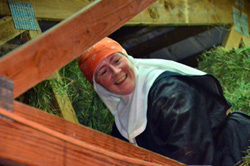 The Furrow is an agricultural magazine published by the John Deere Company. An article entitled Faithful Farmers was published in the January 2015 issue, pages 42-49. Journalist Joe Link captures the essence of our approach to stewardship of the land in the context of our Benedictine spirituality. Members of our Novitiate: postulant Gwyneth Owen (now Sister Teresa Benedicta) and postulant Suzanne Erickson (now Sister Jeanne Paul) are featured. The article is accompanied by gorgeous photographs of our young community members at our daily celebration of the Mass, at work on our land, and caring for our animals. Reflections from more "seasoned" members of the community, responsible for the beef and dairy herds and gardens are included. The Furrow is an agricultural magazine published by the John Deere Company. An article entitled Faithful Farmers was published in the January 2015 issue, pages 42-49. Journalist Joe Link captures the essence of our approach to stewardship of the land in the context of our Benedictine spirituality. Members of our Novitiate: postulant Gwyneth Owen (now Sister Teresa Benedicta) and postulant Suzanne Erickson (now Sister Jeanne Paul) are featured. The article is accompanied by gorgeous photographs of our young community members at our daily celebration of the Mass, at work on our land, and caring for our animals. Reflections from more "seasoned" members of the community, responsible for the beef and dairy herds and gardens are included.Mr. Link has generously made available a PDF file of the full article and photographs for you to download and enjoy. It’s part of our spirituality
to have land we work. This is a way of
getting to know God’s creation. It’s a way for people to get to understand themselves. Mother Augusta Collins in Faithful Farmers article, published in The Furrow Magazine LENT—BLESSING OF SEEDS Very truly I tell you, unless a kernel of wheat falls to the ground and dies, it remains only a single seed. But if it dies, it produces many seeds.
John 12:24 In his Holy Rule in Chapter 49, On the Observance of Lent, St. Benedict exhorts us: The life of a monk ought at all times to be lenten in its character; but since few have the strength for that, we therefore urge that in these days of Lent the brethren should lead lives of great purity, and should also in this sacred season expiate the negligences of other times. Each community member is asked to offer something to God ...over and above the measure prescribed for him... with the admonition that each tell the abbot/abbess what he or she is offering in order to receive the blessing of authority. At Regina Laudis this offering takes the form of Lenten Resolutions, written down and shared with Mother Abbess and placed on the altar during Mass on the First Sunday of Lent. 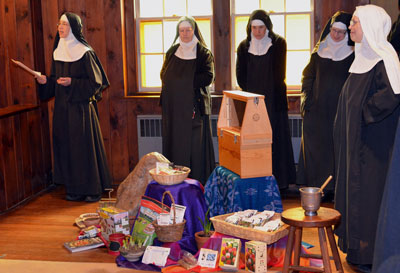 It is also our custom on this day to have a Blessing of Seeds that will be planted in the Spring. Mother Subprioress Margaret Georgina who is in charge of the Abbey's vegetable gardens introduced the blessing to the community, monastic interns and guests gathered in the Lower Monastery Chapel: It is also our custom on this day to have a Blessing of Seeds that will be planted in the Spring. Mother Subprioress Margaret Georgina who is in charge of the Abbey's vegetable gardens introduced the blessing to the community, monastic interns and guests gathered in the Lower Monastery Chapel:As a Benedictine community we live a life related in a fundamental way to the cycles of the earth. Our monastic custom of blessing the seeds on the
first Sunday of Lent allows us to make many associations. One very powerful one is to think of ourselves as seeds going into this unknown time of Lent, in relationship to Christ, with the prayer to give ourselves as fully as we can.
In the words of Christ: 'Unless a seed fall into the ground and die, it remains a seed.' So today we have before us the seeds, for forage crops, flowers, vegetables,
tulip bulbs brought from Holland by Rick Roark and the gift seeds from Crosman's. But the seed needs a lot of assistance, so we have some of the seeding equipment, trays and boxes, water and soil blockers— to remind that we can't do it alone.
After blessing the seeds and bees Mother Abbess prayed that the resolution offered by each one of us would bear fruit this Lent.
And we accent in particular today our dependence on the bees for pollination. Here we have this observation beehive, which is on its way with M. Ozanne to a meeting this afternoon of young people called the Wanna Bees. The queen that is in here is home grown I am told. And it is the time of seeding of the bees. So as we offer the traditional blessing of the seeds, it we hope that this prayer extends to the seed that is each of us, beginning this movement together into Lent, depending on one another. GALLERY OF 2014 LENTEN BLESSING OF SEEDS AND BEES
HAY AND APPLE HARVESTS 2013 was a banner year for our hay and apple harvests. A record 8,725 hay bales were harvested. The hay season lasted from June to October with 14 fields harvested during the 1st cutting and 10 fields during the 2nd cutting. The work of the hay harvest is coordinated by Mother Augusta and the Hay Group who keep a watchful eye on the weather. Three successive days of warm dry weather are needed for cutting, tedding the hay for drying, and baling. Our community is extremely grateful to the volunteers, friends, family members and Monastic interns who help bring in the hay. Although the work is heavy and usually carried out on very hot summer days, there is a spirit of joy and cooperation. Everyone has a role: cutting, tedding, baling the hay, carrying bales, stacking the trucks, driving the trucks, stacking hay in barns and providing much-needed drinks and refreshments. 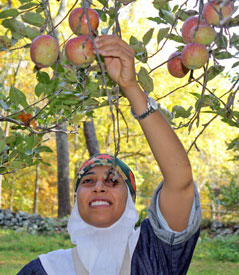 The day culminates in the group singing the Salve Regina in gratitude for the harvest and safety of all who participated in the work day. The day culminates in the group singing the Salve Regina in gratitude for the harvest and safety of all who participated in the work day.This year New England had a gorgeous autumn with mild crisp weather during the days and cool nights. And with autumn comes the apple harvest. During our October Retreat month, community members and Monastic interns harvested 60 bushels of apples. The yield from our 10 apple trees included Empire, Macoun, and Red and Golden Delicious varieties. Hay Harvest 2013
Apple Harvest
|
|||||||||||||||||||||||||||||||||||||||||||||||||||
| Copyright © 2013 Abbey of Regina Laudis. All rights reserved. | ||||||||||||||||||||||||||||||||||||||||||||||||||||